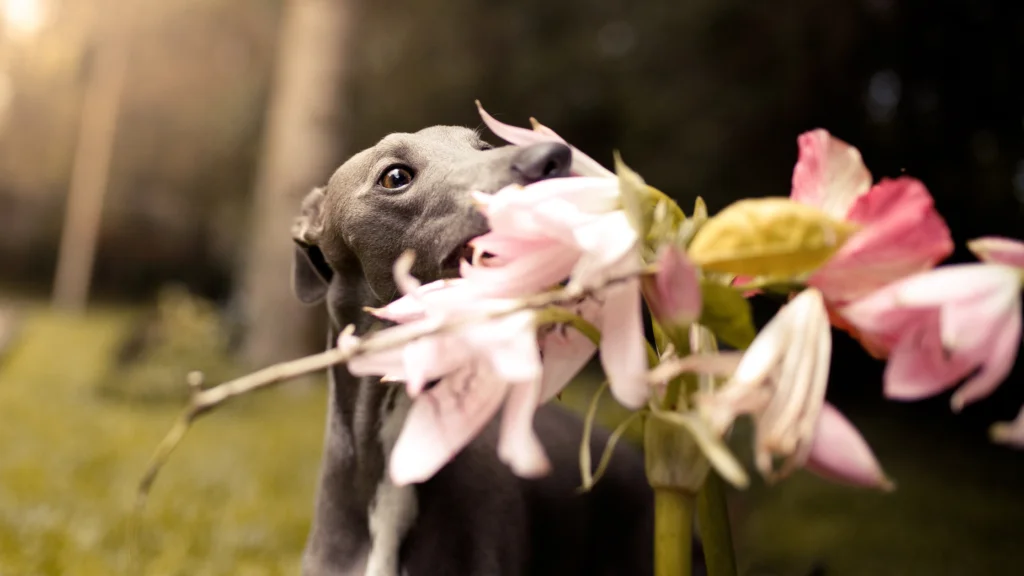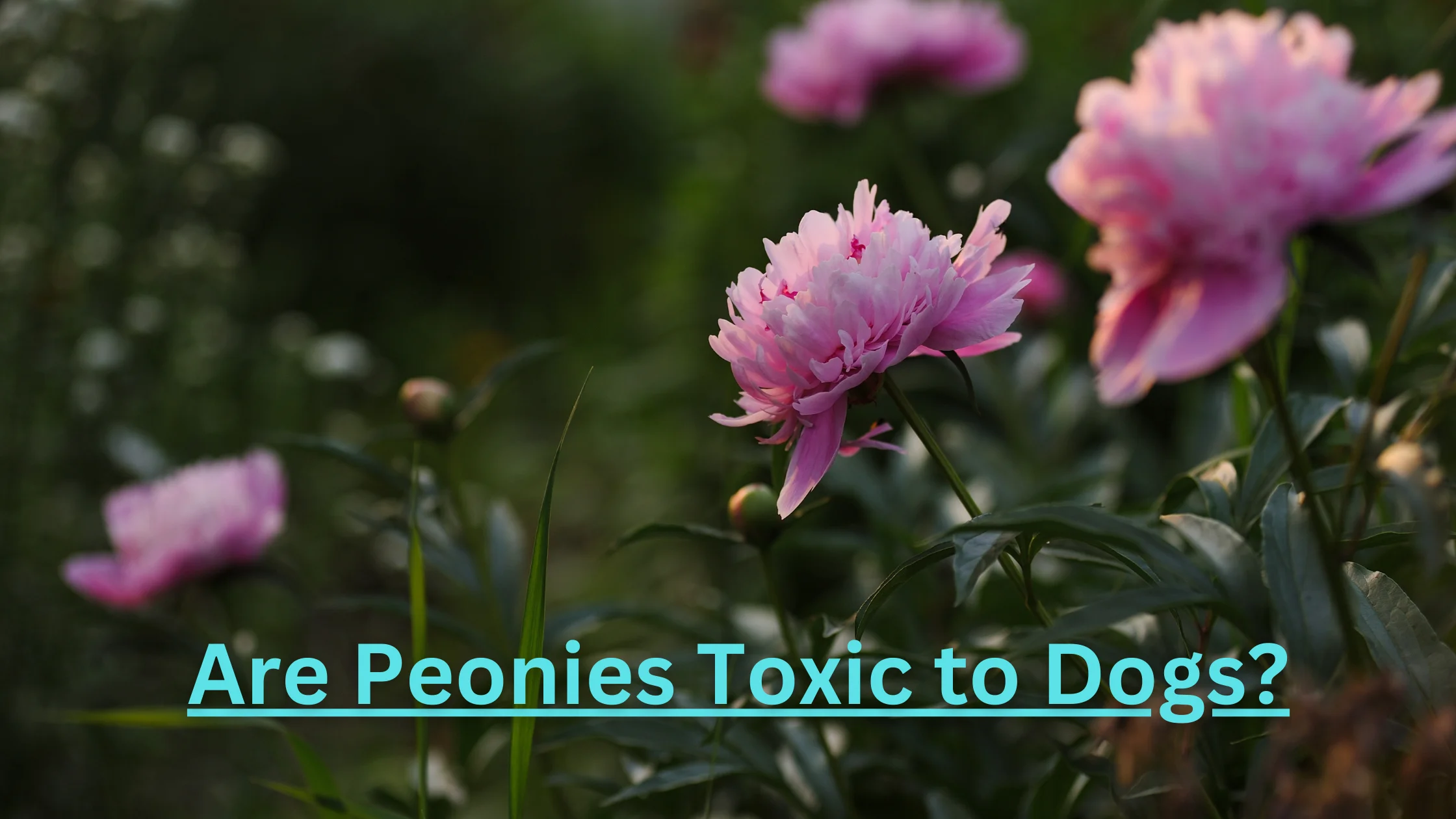As a pet owner, one of your top priorities is keeping your furry friend safe and healthy. While most of us know to keep harmful substances like cleaning products and medications out of reach, many may not be aware that certain plants and flowers can be toxic to dogs. Peonies, for example, are a popular and beautiful addition to many gardens and floral arrangements. Still, they can be dangerous if ingested by dogs. In this article, we’ll explore Are Peonies Toxic to Dogs? The potential risks of peony ingestion for dogs, the symptoms of peony poisoning, and how to keep your dog safe.
What are peonies? Are Peonies Toxic to Dogs?

Peonies are a widespread flowering plant native to Asia, Europe, and Western North America. They are known for their large, colorful, and fragrant blooms and are often used in gardens and as cut flowers in floral arrangements. Peonies come in various colors, including white, pink, red, and yellow. They are a popular choice for weddings and other special events. While peonies are generally considered safe for humans, they can pose a potential dog risk if ingested.
What part of the peony is poisonous to dogs?
All parts of the peony plant contain substances that can be toxic to dogs if ingested, including flowers, stems, leaves, and roots. The toxic compounds in peonies are called Paeonol and paeoniflorin, which can cause a range of symptoms in dogs if consumed in sufficient quantities. These symptoms can range from mild gastrointestinal upset, such as vomiting and diarrhea, to more severe reactions, such as seizures and coma. Ingesting large amounts of peonies can also lead to heart and respiratory failure, which can be life-threatening. It’s essential to keep your dog away from peonies and other potentially toxic plants to prevent accidental ingestion.
Also Read: Can Dogs Eat Lemon Pepper? Is lemon pepper safe for dogs?
What are the symptoms of peony poisoning in dogs?
The symptoms of peony poisoning in dogs can vary depending on the amount of plant material ingested and the size and health of the dog. Some of the most common symptoms of peony poisoning in dogs include:
- Vomiting and diarrhea
- Abdominal pain and cramping
- Loss of appetite
- Lethargy and weakness
- Dehydration
- Pale gums
- Excessive drooling and panting
- Rapid heart rate
- Tremors and seizures
- Coma
Suppose your dog exhibits these symptoms after ingesting peonies or any other potentially toxic plant. In that case, it’s essential to seek veterinary attention immediately. Prompt treatment can help prevent serious complications and improve your dog’s chances of full recovery.
My dog just ate a peony – What to do if your dog ingests peonies?
Suppose you suspect that your dog has ingested peonies or any other potentially toxic plant. In that case, it’s essential to seek veterinary attention right away. Here’s what you should do:
- Remove your dog from the area and any remaining plant material.
- Call your veterinarian or a pet poison control hotline immediately. They can provide guidance on what to do next and advise whether you need to bring your dog in for treatment.
- If your veterinarian advises you to induce vomiting, follow their instructions carefully. Do not induce vomiting unless instructed to do so by a veterinary professional.
- If you’re instructed to bring your dog to the vet, bring a sample of the plant or any remaining plant material with you for identification purposes.
- Follow your veterinarian’s treatment plan carefully and monitor your dog closely for any changes in behavior or symptoms.
Remember, prompt action is the key to successfully treating plant poisoning in dogs. Don’t hesitate to contact your veterinarian if your dog has ingested a toxic plant like peonies.
How to prevent your dog from ingesting peonies?

Here are some tips to help prevent your dog from ingesting peonies:
- Keep peonies and other potentially toxic plants out of your dog’s reach. If you have peonies in your garden or home, ensure they are securely fenced off or placed in an area your dog cannot access.
- Supervise your dog when outside. Keep an eye on your dog in the yard or on walks to ensure they don’t come into contact with any toxic plants.
- Train your dog to leave plants alone. Teaching your dog the “leave it” command can help prevent them from eating things they shouldn’t, including plants.
- Use deterrents. Some dogs may be deterred by taste or smell deterrents that can be sprayed on plants. Also, placing barriers like chicken wire around plants to prevent access.
- Be aware of other plants that are toxic to dogs. Make sure you know which plants are toxic to dogs and take steps to prevent your dog from coming into contact with them.
Following these tips can help keep your dog safe from peony poisoning and other plant-related illnesses. If you need clarification on whether a plant is safe for your dog, consult your veterinarian or a veterinary toxicologist for guidance.
Safe alternatives to peonies for your home and garden
Suppose you’re concerned about the potential risks of peonies and other toxic plants. In that case, you can consider many safe and dog-friendly alternatives for your home and garden. Here are a few options to consider:
- Marigolds – These colorful flowers are an excellent choice for adding color to your garden. They’re non-toxic to dogs and other pets, making them a safe option for any pet owner.
- Petunias – Petunias are another dog-friendly option that comes in various colors. They can be used as ground cover or in pots and hanging baskets.
- Snapdragons – These pretty flowers are popular for adding height to garden beds and come in various colors. They’re also non-toxic to dogs, making them a safe option for pet owners.
- Sunflowers – Sunflowers are an excellent option for adding height and color to your garden. They’re non-toxic to dogs and can be a fun addition to your dog’s outdoor play area.
- Herbs – Herbs like basil, parsley, and thyme are safe for dogs and can also be used to add flavor to your cooking. They can be grown in pots or garden beds and are easy to care for.
Always do your research and consult a veterinary professional if you need clarification on whether a plant is safe for your dog. By choosing dog-friendly plants for your home and garden, you can keep your pet safe and healthy while enjoying the beauty of nature.
Other common flowers and plants toxic to dogs
Many flowers and plants can be toxic to dogs; you must be aware of them if you’re a pet owner. Here are a few other common flowers and plants that can be toxic to dogs:
- Lilies – are highly toxic to dogs; even small amounts can cause severe illness or death. This includes Easter lilies, tiger lilies, and daylilies.
- Daffodils – Daffodils contain toxic alkaloids that can cause vomiting, diarrhea, abdominal pain, and even convulsions in dogs.
- Tulips – Tulips contain toxic alkaloids that can cause gastrointestinal upset, loss of appetite, and depression in dogs.
- Azaleas and Rhododendrons – These plants contain toxins called grayanotoxins that can cause vomiting, diarrhea, and even coma or death in dogs.
- Sago Palms – Sago’s palms contain cycasin. This toxin can cause vomiting, diarrhea, seizures, liver failure, and even death in dogs.
It’s important to note that this is not a comprehensive list, and many other flowers and plants can be toxic to dogs. Before introducing new plants to your home or garden, consult a veterinarian if you suspect your dog has ingested a poisonous plant.
Frequently Asked Question
Are all parts of the peony plant toxic to dogs?
Yes, all parts of the peony plant, including the flowers, leaves, and roots, contain substances that can be toxic to dogs.
How quickly do symptoms of peony poisoning appear in dogs?
Symptoms can appear within a few hours of ingestion but may take up to a few days to develop.
What should I do if I suspect my dog has ingested peonies?
Contact your veterinarian immediately, even if your dog is not showing symptoms yet. Your vet can help you determine the best action based on your dog’s situation.
Can peony poisoning be fatal for dogs?
In severe cases, peony poisoning can be fatal. You must seek veterinary care immediately if you suspect your dog has ingested peonies.
Are there any safe alternatives to peonies for my garden or floral arrangements?
Yes, there are many safe options for adding beauty to your home or garden. Some secure plant options for dogs include marigolds, petunias, and sunflowers.
Also Read: Are Orbeez Toxic to Dogs? A Comprehensive Guide
Conclusion: Protecting your dog from potential hazards
As a pet owner, you must know the potential hazards that can harm your furry friend. This includes being informed about the toxicity of certain plants and flowers, such as peonies, and taking steps to protect your dog from ingesting them.
By being aware of the symptoms of poisoning, you can act quickly to seek veterinary care and potentially save your dog’s life. In addition, knowing about safe alternatives and preventing access to toxic plants can help keep your dog healthy and happy.
Ultimately, being a responsible pet owner means staying informed about potential hazards and taking steps to protect your furry friend from harm. Doing so allows you to enjoy a happy and healthy relationship with your beloved dog for years to come.
